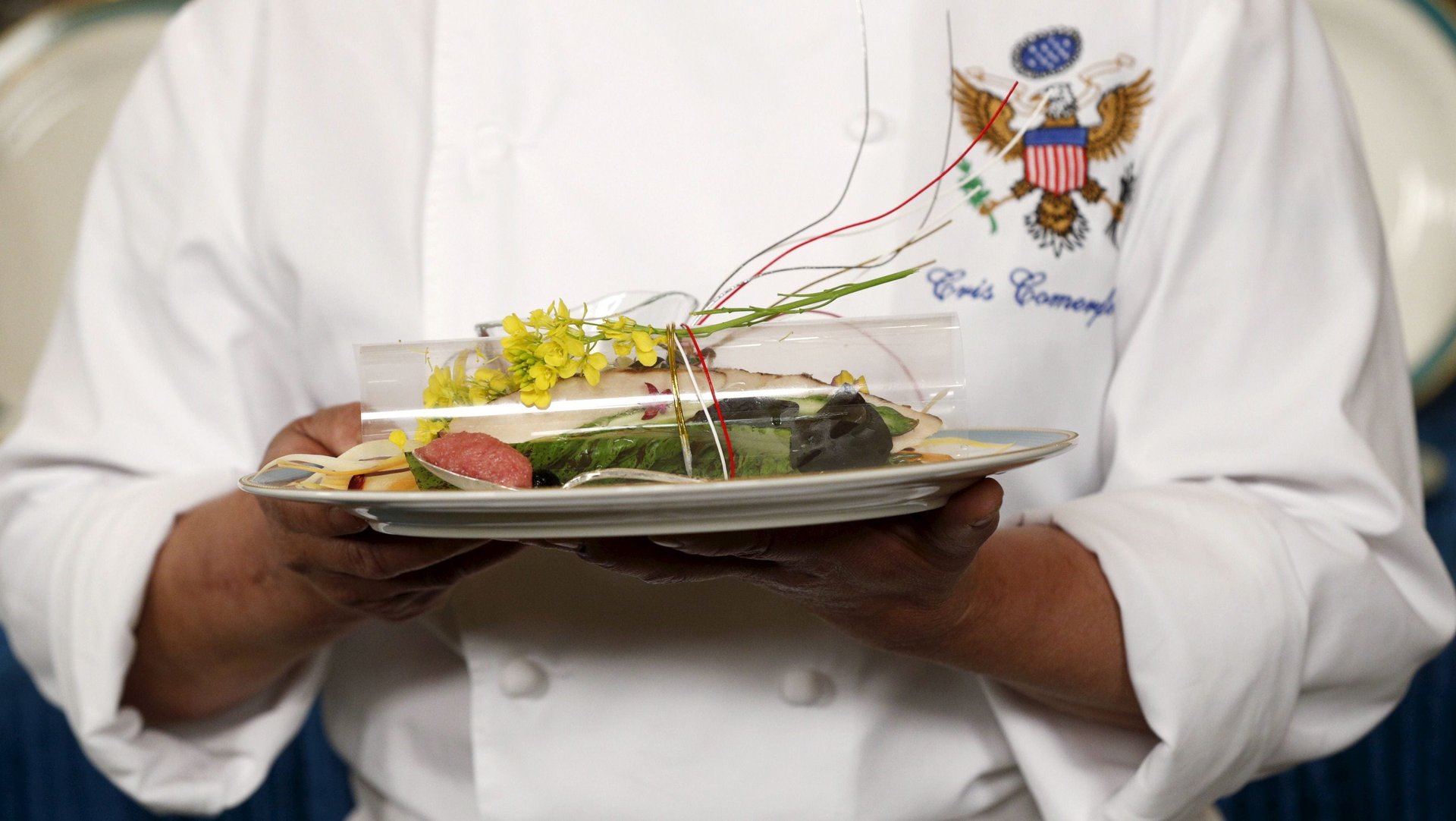The menu for the Trumps’ first state dinner tells a complex American story
Donald and Melania Trump are hosting their first state dinner tonight, honoring French president Emmanuel Macron, and the menu that the White House has released is not what you might expect from a teetotalling president who has sung the praises of well-done steak, ketchup, fast food (paywall), and chocolate cake.


Donald and Melania Trump are hosting their first state dinner tonight, honoring French president Emmanuel Macron, and the menu that the White House has released is not what you might expect from a teetotalling president who has sung the praises of well-done steak, ketchup, fast food (paywall), and chocolate cake.
State dinners are far larger, more formal affairs than the hosting the Trumps have done at Mar a Lago, and they’re generally seen as an opportunity for the first lady to practice the soft diplomacy of wine, table china, and sparkling conversation.
The images and publicity materials that the White House has released so far have touted the flower arrangements—1,500 cherry blossom branches, and more than 1,000 stems of white lilacs—far more than the food, and it’s impossible to know whether the Trumps themselves offered much input on the menu.
In any case, Cristeta Comerford, the White House executive chef since 2005, will serve a meal that tells its own story. This is not the traditionalist meat-and-potatoes feast you’d expect at a Trump-owned hotel. Instead, the menu brings French influence to bear on American ingredients, in dishes that call back to both countries’ proud, complex histories. The wine pairings follow suit, highlighting American winemakers, and all three—a chardonnay, pinot noir, and a sparkling wine that uses French winemaking techniques with a grape developed in California—are a thoughtful mix of old and new world styles.
Taken as a whole, the menu tells a nuanced story of global mobility, the back-and-forth flow of cultural influence, and hard-scrabble ingenuity. Let’s take a look, course by course.
First Course:
Goat Cheese Gateau
This is straight-up Brooklyn, farm-to-table cuisine—circa 2011. A goat cheese gateau is hard to resist. The lettuces are from the White House kitchen garden. And “buttermilk biscuit crumbles” sound like the buttery, baking-soda-leavened American bread is given the crouton treatment. These dishes would be at home at any new American bistro in a city today, and the whole thing sounds pleasant enough to satisfy all but the most jaded kale salad aficionado.
Main Course:
Rack of Spring Lamb
Spring lamb is a traditional delicacy on both sides of the Atlantic. Burnt cipollini soubise, a charred variation on the French sauce that combines onions, butter and cream, is a nice way to fancy up the meat, and a nod to classic French technique.
But jambalaya is not lamb’s natural sidekick, and this is where things really get interesting. The Louisiana rice dish, like a paella or a biriyani, is usually served as a one-pot meal, containing various meats, sausages, shrimp, or other seafood. There are as many ways to make a jambalaya as there are cooks, and recipes are often jealously guarded by generations of families. The ingredients and techniques show a mix of French, Spanish, Cajun, and Creole cultures. Depending on who you ask, the dish is either a luxurious banquet food or a cheap way to feed a lot of people—or both.
The choice to highlight the Carolina Gold rice in the dish is also telling. A long-grain rice that became a staple crop in the Carolinas in the 18th century, Carolina Gold helped define Lowcountry cuisine. But there’s also a dark side to that history: The grain’s success created more demand for African slave labor on rice plantations. Gold rice fell out of favor as new strains that could be machine harvested were planted, slavery ended, and a series of hurricanes changed the growing conditions. Now prized as a rediscovered heritage grain, the inclusion of Carolina Gold in a state dinner underscores how food can speak to identity and history, and the way staple crops can shape a society (paywall).
Dessert:
Nectarine Tarts
This sounds very delicious, and the ice cream is a clear French-inflected twist on pie à la mode, but the nectarines are a cipher. Nectarines are not yet in season in the US, not even in Southern California or Texas. It’s a delicious stone fruit, yes, but why not strawberries? They are in season in the country’s south, and would dovetail nicely with the jambalaya and the kitchen garden greens. Rhubarb is also in season right now, and can be exceedingly elegant.
Maybe Comerford—or the Trumps—just felt like nectarines. And thanks to the wonders of today’s global economy, that was possible.